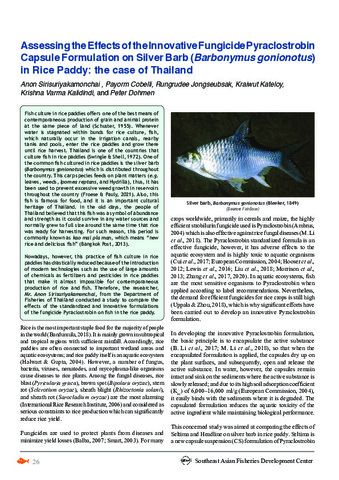Assessing the effects of the innovative fungicide pyraclostrobin capsule formulation on silver barb (Barbonymus gonionotus) in Rice Paddy: the case of Thailand
Share
抄録
Fish culture in rice paddies offer one of the best means of contemporaneous production of grain and animal protein at the same piece of land (Schuster, 1955). Whenever water is stagnated within bunds for rice culture, fish, which naturally occur in the irrigation canals, nearby tanks and pools, enter the rice paddies and grow there until rice harvest. Thailand is one of the countries that culture fish in rice paddies (Swingle & Shell, 1972). One of the common fish cultured in rice paddies is the silver barb (Barbonymus gonionotus) which is distributed throughout the country. This carp species feeds on plant matters (e.g. leaves, weeds, Ipomea reptans, and Hydrilla), thus, it has been used to prevent excessive weed growth in reservoirs throughout the country (Froese & Pauly, 2021). Also, this fish is famous for food, and it is an important cultural heritage of Thailand. In the old days, the people of Thailand believed that this fish was a symbol of abundance and strength as it could survive in any water sources and normally grew to full size around the same time that rice was ready for harvesting. For such reason, this period is commonly known as kao mai pla man, which means “new rice and delicious fish” (Bangkok Post, 2013).
Nowadays, however, this practice of fish culture in rice paddies has drastically reduced because of the introduction of modern technologies such as the use of large amounts of chemicals as fertilizers and pesticides in rice paddies that make it almost impossible for contemporaneous production of rice and fish. Therefore, the Department of Fisheries of Thailand in collaboration with the Department of Rice of Thailand and BASF Thai Ltd. (BASF originally the “Baden Aniline and Soda Factory”) conducted a study to compare the effects of the standardized and innovative formulations of the fungicide Pyraclostrobin on fish in rice paddy.
Suggested Citation
Sirisuriyakamonchai, A., Cobelli, P., Jongseubsak, R., Kateloy, K., Kalidindi, K. V., & Dohmen, P. (2021). Assessing the effects of the innovative fungicide pyraclostrobin capsule formulation on silver barb (Barbonymus gonionotus) in Rice Paddy: the case of Thailand. Fish for the People , 19(2), 26-31. http://hdl.handle.net/20.500.12066/6689


